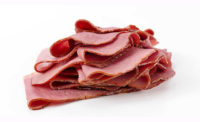Replacing phosphates
Phosphate substitutes increasing in marinades and brines.

Phosphates are one of the most well-known and least understood ingredients in meat marinades and brines. Because they aren’t allowed in organic and natural products — and consumers are pushing for substitutes in other items — expect to see more phosphate substitutes in the future.
“While most ingredients directly manage added water in the formulation, phosphates manage the muscle food proteins and thus the water already inherent in the meat tissue plus additional formula water,” says Wes Schilling, Ph.D, professor of food science, Mississippi State University.
Phosphates have a number of functions, which makes them unique. “They are basic compounds that raise the pH of meat mixes,” says Joseph G. Sebranek, Ph.D, Charles F. Curtiss Distinguished Professor in Agriculture and Life Sciences, Iowa State University, in Ames, Iowa. “This allows greater swelling of the meat structure to increase space between proteins. The increased space in the meat structure means the meat will absorb and hold greater amounts of water, similar to how a sponge absorbs and holds water.”
They increase the emulsifying capacity of the meat and allow for more space to bind water in marinated products, Schilling says. Phosphates also “function as a buffer and resist pH changes when acids are added to the meat product,” he says.
Moreover, they control some bacteria growth and help meat resist oxidation, Sebranek says.
These qualities are beneficial in processed meats that are cooked and stored, says Edward W. Mills, Ph.D, associate professor of meat science at Pennsylvania State University, in University Park, Penn. Phosphates, however, cannot be used with organic or natural products. And customers apparently don’t want to see them on other labels.
“If you replace phosphates, then you have two big functions to solve: its water-holding function and ability to help meat resist oxidation,” Mills says. “I can’t say that I’ve seen any ingredients do both.”
Most often, multiple ingredients are needed to replace the functionality of phosphates, and usually at a much higher price, says Schilling. Polysaccharide mixes, fibers, and proteins are common substitutes.
To control oxidation and flavor, ingredients such as spice extractives, rosemary extract, and oil are utilized as antioxidant materials, Mills says. Green tea blends and cherry powder extracts can also help maintain beef’s red color.
“Modified food starches and protein ingredients like a whey protein mix will increase water binding,” Mills says. Other possible substitutes to increase yield are carrageenan and oat and plum fiber mixes.
At this point, phosphate substitutes are already commonly used. But, “I also don’t believe there is such a thing as a phosphate replacer,” says Schilling. “I would call them phosphate substitutes because phosphate’s functionality is the gold standard and cannot be replaced.”
Phosphate substitutes will continue to be used because it is what customers (i.e., food companies, retail, foodservice) are demanding and because consumers do not want them on labels because of a perceived negative connotation to them, Schilling says.
“There’s a major perception by consumers that phosphates are chemical compounds,” Sebranek says. “Consumers are driving the market and they are willing to pay for what they want, so we need to pay attention.”
As manufacturers experiment with phosphate alternatives, they are finding that there isn’t one easy replacement, and duplicating phosphate’s functions will take multiple ingredients. In the meantime, perhaps consumers could learn more about phosphates, as well.
“Phosphate is naturally in the body and without adenosine triphosphate (ATP), we couldn’t live,” says Schilling. “Phosphate is not a bad ingredient just like salt is not a bad ingredient. They just need to be used responsibly and consumed responsibly.”
Looking for a reprint of this article?
From high-res PDFs to custom plaques, order your copy today!







